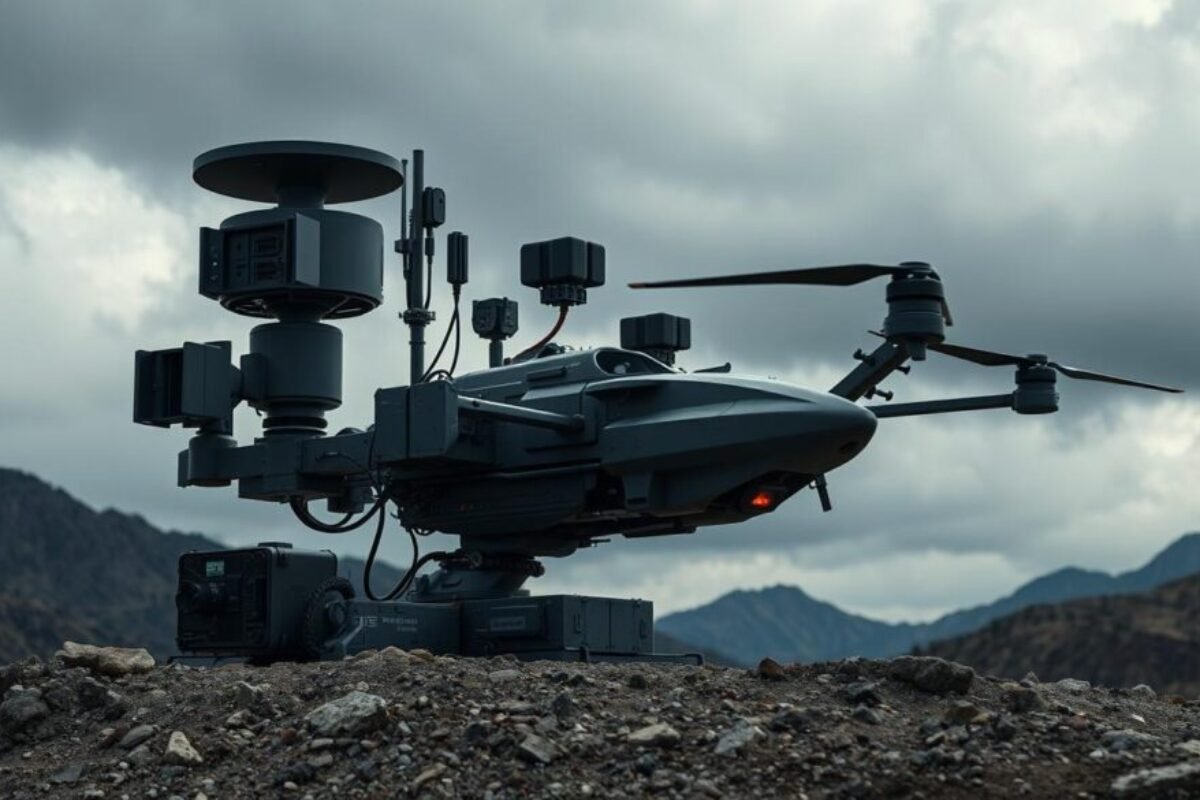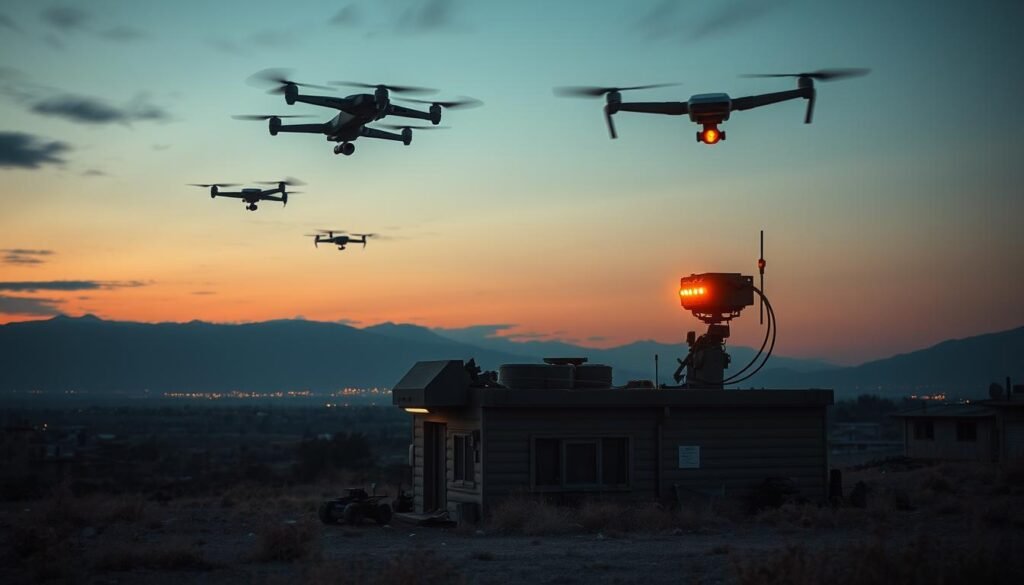Counter-Drone Technologies: How Nations Are Fighting Back.
Did you know the global market for counter-drone tech is set to hit over $6 billion by 2025? This huge number shows how important it is for countries to have strong drone defense systems. These systems help protect against the growing threat of unmanned aerial vehicles (UAVs). They are key for keeping national security and control over the skies.
Countries like Ukraine and Israel have seen the power and risks of UAVs firsthand. Their experiences have pushed the development and use of advanced counter-drone systems. We’ll explore the strategies and tech shaping the future of aerial warfare and security.
Key Takeaways
- The market for counter-drone technologies is expected to exceed $6 billion by 2025.
- Robust drone defense solutions are vital for national security and control over the skies.
- Ukraine and Israel have been key in improving counter-drone tech.
- Advances in UAVs bring both chances and dangers.
- It’s essential to develop counter-drone systems to protect important infrastructures.
Introduction to Counter-Drone Technologies
In today’s fast-changing world, counter-drone technologies are key for safety and security. As drones get smarter and easier to use, we need strong anti-drone solutions and top-notch drone detection systems.
What are Counter-Drone Technologies?
Counter-drone tech includes many systems and strategies to find, track, and stop unauthorized drones. From advanced radar to electronic warfare, these tools help us fight back against drones in both civilian and military areas. They help keep our important places and skies safe.
The Evolving Threat of Drones
The danger from drones is growing as they become more common and powerful. Armed drones have been used in wars, showing they can get past old defenses. So, we must keep improving our anti-drone defenses fast. With better drone detection and defense tech, we can protect ourselves against these new aerial threats.
The Need for Counter-Drone Technologies
In today’s fast-changing world, strong UAV defense systems are essential. Unmanned Aerial Vehicles (UAVs) are used in many areas, not just by the military. But, their wide use also means more risks and misuse.
Rise of Unmanned Aerial Vehicles (UAVs)
UAV technology has grown a lot in the last ten years. Companies use them for taking pictures from the air, delivering goods, and checking crops. Governments use them for watching over areas, managing disasters, and finding missing people. This growth means we need good ways to protect places and keep people safe.

Potential Threats and Misuse
Even though UAVs are useful, they can be dangerous if used the wrong way. They can be used for spying, stealing secrets, or even attacking. To deal with these risks, we need to have systems that can spot and stop rogue drones. This way, we can enjoy the benefits of UAVs while keeping everyone safe.
Types of Counter-Drone Systems
The rise of unmanned aerial vehicles (UAVs) makes it key to know about drone mitigation technology. There are two main types of anti-drone systems: kinetic and non-kinetic. Each type has its own ways to handle unmanned aerial vehicle countermeasures.
Kinetic Counter-Drone Systems
Kinetic systems aim to physically stop or destroy drones. They use projectiles or missiles to hit and take down the UAV. This method is quick and effective, perfect for urgent situations.
Non-Kinetic Counter-Drone Systems
Non-kinetic systems, on the other hand, use less force but are just as effective. They use signal jamming and other electronic warfare to mess with the drone’s controls. This way, they can stop drones without harming the area around them.
Kinetic Systems: Projectiles and Missiles
In the world of drone defense solutions, kinetic systems are a top choice. They use projectiles and missiles to knock drones out of the sky. To work well, they need good detection, tracking, and aiming.
Kinetic systems are great for dealing with fast or tricky drones. They use radar or optical systems for precise aiming. This makes them very effective.
The Mechanics of Kinetic Systems
It’s important to know how kinetic systems work. They use different types of projectiles, like guided missiles. First, they spot a drone, then track and aim it with advanced tech.
After locking in, a projectile is fired to hit and destroy the drone. This method is simple and quick, making it key for airspace security systems.

Case Studies: Ukraine and Israeli Use of Kinetic Systems
Ukraine and Israel lead in using kinetic systems for airspace security. Ukraine often uses missiles to fight off drones. Israel also uses kinetic methods to protect its skies.
Both countries use a mix of radar and optical systems. This ensures drones are taken down quickly and effectively.
The table below shows some systems Ukraine and Israel use:
| Country | System | Type | Effectiveness |
|---|---|---|---|
| Ukraine | S-300 | Missile | High |
| Israel | Iron Dome | Projectile | Very High |
These examples show kinetic systems are vital for drone defense. Improving these systems will help face new aerial threats.
Non-Kinetic Systems: Electronic Warfare
Non-kinetic counter-drone systems have changed the game in electronic warfare. They offer advanced ways to fight drone threats without harming them physically. These systems use smart drone tools and interference tech to mess with drones, keeping them safe and under control.
How Non-Kinetic Systems Work
These systems use tactics like RF jamming and spoofing to mess with rogue drones. They disrupt the radio signals that control drones, stopping them from getting or following orders. Spoofing sends fake signals to drones, making them go off course or head back home.
This method is safe because it doesn’t cause damage. It’s a way to stop drones without harming people or things nearby.
Advantages and Challenges
The big plus of non-kinetic systems is they handle drone threats well without using force. This lowers the risk of damage in crowded areas. They also work better and more precisely than old methods.
But, they face challenges. New drone tech, like better encryption and frequency hopping, can make them less effective. So, it’s key to keep improving drone tools and tech to stay ahead of threats.
Radar-Based Detection Systems
Radar is key in fighting against drones. It helps detect drones from far away, which is great for national defense. With radar, countries can watch their skies closely and stop threats before they start.
Role of Radar in Drone Detection
Radar is vital for spotting and tracking drones. It can tell how big, fast, and high a drone is. This info is key for stopping drones in the air. Radar is a big part of keeping skies safe today.
Examples from Ukraine
Ukraine leads in using radar to fight drones. During conflicts, radar has shown its value by tracking drones in real-time. This helps Ukraine stay safe by acting fast against threats.

Ukraine’s success with radar shows how important it is for defense. Using these systems helps countries get ready for new drone threats.
Radio Frequency Jamming and Hacking
Exploring radio frequency jamming and hacking shows their key role in fighting drones.
How RF Jamming Disrupts UAVs
RF jamming drone tech is a strong way to block a drone’s link to its controller. It floods the air with signals, stopping the drone from getting orders. This makes the drone land or go back to its starting point.
This method is a key part of our defense, giving us an edge without harming the drone.
Hacking into Drone Controls
Hacking drone controls uses weaknesses in the drone’s signals to take control. It lets us steer the drone or gently bring it down. Unlike jamming, hacking changes the drone’s orders directly.
This gives us a more precise way to stop threats. Both jamming and hacking are essential for keeping our skies safe, in both military and civilian areas.
Laser Weapon Systems
Laser weapon systems are leading the way in fighting drones. They can take out threats quickly and accurately. Using high-energy lasers, these systems focus intense energy on drones, damaging them badly.
Unlike old methods, laser drone defense hits its mark without harming nearby things. This makes it perfect for cities.

The main benefit of laser systems is their precision targeting technology. This lets us aim with unmatched accuracy. It means no harm to people or buildings nearby, which is great for cities.
As these systems get better, they will be key in defending us today and tomorrow.
| Feature | Details |
|---|---|
| Technology | High-Energy Lasers |
| Targeting | Precision Targeting Technology |
| Application | Laser Drone Defense |
| Impact | Minimized Collateral Damage |
Integration of Multiple Counter-Drone Solutions
The best way to fight UAV threats is with an integrated UAV defense system. It uses radar, laser, kinetic, and electronic systems. This creates a multi-layered drone defense that is flexible and has backup plans.
This integrated UAV defense system has different ways to handle various situations. Radar finds drones early, giving time to use other methods. Laser systems are precise, perfect for fast or tricky drones.
One senior defense analyst noted, “The key to successful UAV defense is not relying on a single technology but integrating multiple layers of defense.”
This method also includes combined countermeasures for new drone tactics. If one method doesn’t work, another can quickly step in. This quick switch is key as drone tech keeps changing.
In summary, using a multi-layered drone defense with combined countermeasures and many technologies is smart. It makes a strong and reliable security system. This all-around strategy keeps us ready for any UAV threat.
Case Studies: Ukraine and Israeli Counter-Drone Efforts
Recently, there have been significant efforts to fight drone threats. Ukraine and Israel have shown how different anti-drone strategies work. They use their unique challenges and tech to their advantage.
Challenges Faced in Ukraine
Ukraine is fighting a tough battle against Russia, with drones playing a big role. They face the challenge of keeping up with effective drone countermeasures against Russia’s advanced drones. The need for quick updates in defense strategies is clear. These case studies in UAV defense highlight the need for strong counter-drone tech.
Technological Responses in Israel
Israel is leading the way with its drone defense tech. They’ve introduced systems like Drone Dome, showing off their innovation. By using radar, jamming, and kinetic solutions, Israel shows a full approach to drone defense. These methods are key case studies in UAV defense, showing Israel’s forward-thinking in anti-drone strategies and effective drone countermeasures.
| Country | Main Challenges | Technological Responses |
|---|---|---|
| Ukraine | Drone-assisted artillery strikes | Adaptive kinetic and non-kinetic countermeasures |
| Israel | Frequent UAV incursions | Advanced systems like Drone Dome |
The Commercial Drone Market and Its Impact
The commercial UAV systems sector is booming, with fast tech progress and new uses. Drones are now used for delivery, aerial photos, and more. But, we need to tackle the challenges with smart anti-drone solutions.
Rapid Advancements in Commercial Drones
The drone world is seeing huge leaps in innovation. Companies like DJI and Amazon Prime Air are leading the way. They’re making drones safer, faster, and able to carry more.
This drive for better technology is pushing everyone to innovate. As a result, drones are getting smarter and are used in many fields. This creates a competitive yet cooperative space.
Implications for Anti-Drone Solutions
The drone market’s growth means we need better anti-drone tech fast. Old methods won’t work against today’s drones. So, we must keep improving our counter-drone tech.
This ensures safety and privacy everywhere. A strong, varied approach is key to fighting off drone threats. It’s all about keeping everyone safe.
Current Limitations and Future Improvements
Drone technology is growing fast, but so are the challenges to stop them. The limitations of current UAV defenses are mainly in handling swarm attacks and finding tiny drones. These small, quick drones are hard to spot with old radar and cameras, making new tech a must.
Identifying Weaknesses in Present Systems
Even with big steps in drone defense, there’s a lot to improve. Current systems struggle to handle many drones at once, and they move fast. Also, needing to see drones to stop them is a big problem in busy cities.
Innovative Solutions on the Horizon
New tech is coming to fix these problems. It includes AI and smart algorithms to predict and react faster. Making defense systems more automatic is key to quick responses and better safety.
New jamming and hacking tech is also on the way. It will change how we defend against drones, making the skies safer for everyone.
Counter-Drone Technologies in Urban Environments
Using counter-drone tech in cities is tricky. Cities are crowded and have lots of buildings and people. New tech aims to protect without harming anyone or anything.
Challenges in Urban Areas
Keeping cities safe from drones is hard. There are lots of buildings and people around. This makes it hard to spot and stop drones.
Also, the many wireless signals in cities mess up jamming signals. Jamming is key to stopping drones in cities.
- Dense Infrastructures: Make it hard to track and stop drones.
- High Civilian Populations: We need to use safe ways to stop drones without bothering people.
Adapting Technologies for City Use
We need to make drone tech work better in cities. It should be accurate and not disrupt daily life. Advanced radar systems are key to spotting drones without confusing them with other city stuff.
Also, we need better ways to stop drones without harming them. This means using electronic warfare more carefully.
The adaptation of these technologies shows our dedication to keeping cities safe from drones.
International Collaboration and Regulations
The drone threat knows no borders, making international partnerships and rules vital. By working together globally, we can better fight unauthorized drone use. Sharing intelligence and aligning strategies are key to success.
Global Alliances Against Drone Threats
Global partnerships are essential in tackling UAV threats. They help nations share resources and knowledge, leading to better defense strategies. For example, NATO helps member countries by organizing joint exercises and setting standards.
Regulatory Frameworks
Strong UAV regulation policies and global standards are critical in fighting drone misuse. Organizations like the International Civil Aviation Organization (ICAO) and the European Union Aviation Safety Agency (EASA) work hard to create and enforce rules. These rules help countries follow the same standards, making cooperation easier.
| Organization | Role | Impact |
|---|---|---|
| NATO | Coordinate efforts among member states | Enhanced joint exercises and standardization |
| ICAO | Develop UAV regulation policies | Unified global standards and compliance |
| EASA | Enforce UAV regulations in Europe | Streamlined regulatory adherence across EU |
Strong global partnerships and strict rules are key to fighting the drone threat. They help keep our skies safe and ensure our defenses keep up with drone technology.
Future Outlook for Counter-Drone Technologies
Counter-drone technologies are evolving fast. This shows how important it is for countries to keep up in UAV defense. As drones get better and threats grow, we need to use new technologies to defend better.
Anticipating Technological Innovations
The next big thing in counter-drone systems will be new tech. AI and machine learning will help us guess drone moves and respond faster. They will also help make decisions on their own.
Using emerging drone technologies will make finding and stopping drones better. We’ll be able to deal with threats faster and more accurately.
Long-Term Strategies
Having long-term plans for drone defense is key. We need to keep improving our defenses to stay ahead of new threats. Our plans should be flexible and able to change with new tech.
We also need to work together with other countries. This way, we can create solutions that work for everyone. This will help us all stay safe from drones.
Conclusion
As we wrap up our look at counter-drone tech, it’s clear that UAVs bring both great chances and big risks. We’ve seen how different systems, like kinetic projectiles and electronic warfare tools, are needed to fight drones. This shows how complex and important it is to defend against drones today.
Looking back, we see big steps forward in UAV defense. Both the military and civilians have made big progress. Countries are using radar, jamming, and laser systems to fight drones. Stories from Ukraine and Israel show how these techs work in real life, with both wins and areas to get better.
As we move forward, the need for new ideas in drone defense is clear. Drones are getting smarter, so we must keep improving our ways to stop them. This ongoing battle will shape how we protect our skies, making it key to stay ahead in tech.






June 28, 2025 @ 1:59 pm
Interesting insights into the growing counter-drone technology market and its importance for global security. The advancements in UAV detection and defense systems seem crucial given the increasing threats. It’s fascinating how countries like Ukraine and Israel are leading in adopting these technologies. How do you see the balance between the benefits of UAVs and the need for robust counter-drone measures evolving in the future? German news in Russian (новости Германии)— quirky, bold, and hypnotically captivating. Like a telegram from a parallel Europe. Care to take a peek?